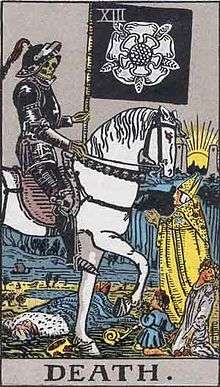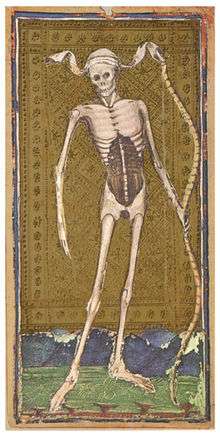Death (Tarot card)


Death (XIII) is the thirteenth trump or Major Arcana card in most traditional Tarot decks. It is used in Tarot, tarock and tarocchi games as well as in divination.
Description
Some decks, such as the Tarot of Marseilles and Visconti Sforza Tarot omit the name from the card, calling this card simply The Card with No Name, thus giving this card a broader and less frightening meaning.
Meaning in Divination
This card simply signifies, in any subject you're inquiring about, "giving up all that is superficial and concentrating on what is basic, fundamental and truly important" in the specific matter you're asking about.
The Death card usually depicts a Grim Reaper, personified Death, sometimes riding a horse but more often wielding a sickle. Surrounding it are dead and dying people from all classes, including kings, bishops and commoners. The Rider-Waite tarot deck depicts the skeleton carrying a black standard emblazoned with a white flower along with the Crashing Towers from The Moon raising with The Sun setting behind them in the background.
The number 13 card shows positive meaning in reverse reading.
Interpretation
According to Eden Gray and other authors on the subject, it is unlikely that this card actually represents a physical death. Typically it implies an end, possibly of a relationship or interest, and therefore implies an increased sense of self-awareness—not to be confused with self-consciousness or any kind of self-diminishment.[1][2]
In fact, Eden Gray interprets this card as a change of thinking from an old way into a new way. The horse Death is riding is stepping over a prone king, which symbolizes how not even royalty can stop change.[3]
The card, drawn in reverse, can be interpreted as stagnation and the inability to move or change according to Eden Gray. [4]
Other versions
- In the Mythic Tarot deck, Death is depicted by Hades.
References
Further reading
| Wikimedia Commons has media related to Death (Tarot). |
- A. E. Waite's 1910 Pictorial Key to the Tarot
- Sir James Frazer The Golden Bough
- Hajo Banzhaf, Tarot and the Journey of the Hero (2000)
- Most works by Joseph Campbell
- The Book of Thoth by Aleister Crowley
- G. Ronald Murphy, S.J., The Owl, The Raven, and The Dove: Religious Meaning of the Grimm's Magic Fairy Tales (2000)
- Riane Eisler, The Chalice and the Blade (1987)
- Mary Greer, The Women of the Golden Dawn (1994)
- Merlin Stone, When God Was A Woman (1976)
- Robert Graves, Greek Mythology (1955)
- Joan Bunning, Learning the Tarot
- Juliette Wood, Folklore 109 (1998):15–24, "The Celtic Tarot and the Secret Tradition: A Study in Modern Legend Making" (1998)